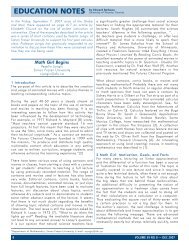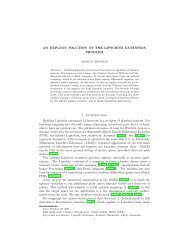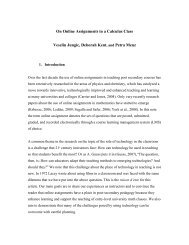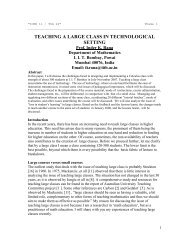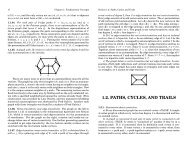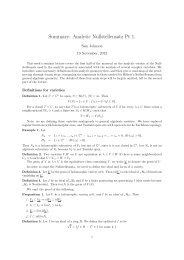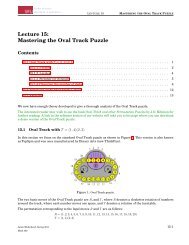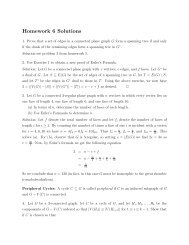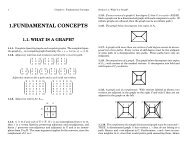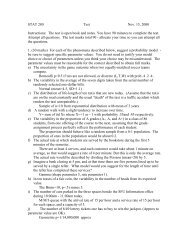Lecture 4: Permutations: Cycle Notation - People.stat.sfu.ca
Lecture 4: Permutations: Cycle Notation - People.stat.sfu.ca
Lecture 4: Permutations: Cycle Notation - People.stat.sfu.ca
Create successful ePaper yourself
Turn your PDF publications into a flip-book with our unique Google optimized e-Paper software.
Week Date Sections<br />
from FS2009<br />
5 Oct 5 III.1, III.2<br />
Part/ References Topic/Sections Notes/Speaker<br />
Combinatorial<br />
parameters<br />
FS A.III<br />
(self-study)<br />
Combinatorial<br />
Parameters<br />
6 12 IV.1, IV.2 Multivariable GFs<br />
Asst #1 Due<br />
7 19 IV.3, IV.4 Analytic Methods Complex Analysis<br />
8<br />
9<br />
FS: Part B: IV, V, VI<br />
26<br />
Singularity Analysis<br />
Appendix B4<br />
IV.5 V.1<br />
Stanley 99: Ch. 6<br />
Nov (b) 2 If β = (a1, Asst #2 Due<br />
Handout a2, . . #1 . , ar) andAsymptotic 1 ≤ i < methods j ≤ r, then<br />
9 VI.1<br />
(self-study)<br />
Sophie<br />
10<br />
12 A.3/ C<br />
Introduction to Prob. Mariolys<br />
11<br />
12<br />
18 IX.1 Limit Laws and Comb Marni<br />
20 IX.2 Random Structures<br />
and Limit Laws<br />
Discrete Limit Laws Sophie<br />
23 IX.3<br />
FS: Part C<br />
(rotating<br />
presentations)<br />
Combinatorial<br />
instances of discrete<br />
Mariolys<br />
25 IX.4 Continuous Limit Laws Marni<br />
13 30 IX.5<br />
f aculty of science MATH 895-4 Fall 2010<br />
department of mathematics Course Schedule<br />
LECTURE 4 PERMUTATIONS: CYCLE NOTATION<br />
22. Splicing and dicing cycles.<br />
1 Sept 7 I.1, I.2, I.3 Combinatorial Symbolic methods<br />
Structures<br />
2 14 I.4, I.5, I.6 Unlabelled structures<br />
FS: Part A.1, A.2<br />
Comtet74<br />
3 21 II.1, II.2, II.3 Labelled structures I<br />
Handout #1<br />
4 28 II.4, II.5, II.6<br />
(self study)<br />
Labelled structures II<br />
3 What happens to the cycle structure of a permutation α when<br />
you follow α by a transposition? The answer is you either splice two of the cycles of α into<br />
one bigger cycle, you cut one of the cycles of α into two smaller cycles, you extend one cycle by<br />
on element, or you add a new transposition to the cycle structure. Verify the special <strong>ca</strong>ses of<br />
this <strong>stat</strong>ement below, and then make an argument that the claim follows in general from these<br />
special <strong>ca</strong>ses.<br />
(a) If α = (a1, a2, . . . , ar)(b1, b2, . . . , bs) where these two cycles are disjoint, then<br />
Quasi-Powers and<br />
Gaussian limit laws<br />
Sophie<br />
14 Dec 10 Presentations Asst #3 Due<br />
Dr. Marni MISHNA, Department of Mathematics, SIMON FRASER UNIVERSITY<br />
Version of: 11-Dec-09<br />
α(a1, b1) = (a1, . . . , ar, b1, . . . , bs).<br />
β(ai, aj) = (a1, . . . , ai−1, aj, aj+1, . . . , ar)(ai, ai+1, . . . , aj−1).<br />
(c) If γ = (a1, a2, . . . , ar) and b = ai for all i, then<br />
γ(a1, b) = (a1, a2, . . . , ar, b).<br />
(d) If δ = (a1, a2, . . . , ar) and if (b1, b2) is disjoint from δ, then<br />
δ(b1, b2) = (a1, a2, . . . , ar)(b1, b2).<br />
3 This exercise is from J. Kiltinen’s book Oval Track and Other Permutation Puzzles.<br />
Jamie Mulholland, Spring 2010<br />
Math 302<br />
12



